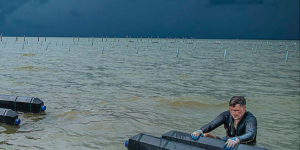 A series of newly published fact sheets for the off-bottom oyster aquaculture industry in the Gulf of Mexico provide guidelines and suggested safety procedures for preparing for tropical storms and hurricanes.
A series of newly published fact sheets for the off-bottom oyster aquaculture industry in the Gulf of Mexico provide guidelines and suggested safety procedures for preparing for tropical storms and hurricanes.
Florida Sea Grant, the Mississippi-Alabama Sea Grant Consortium and Louisiana Sea Grant created the “Tropical storm and hurricane preparedness for off-bottom oyster aquaculture in the Gulf of Mexico” series to help oyster farmers reduce damages related to wind, storm surge and decreased salinity from flooding. The six publications focus on planning, preparation and recovery for different types of farms, facilities and equipment:
- Introductory Planning Guide
- Land-based Operations Guide
- Workboat Guide
- Adjustable Long-Line Farms Guide
- Floating Cage Farms Guide
- Floating Bag Farms Guide
The guides help growers create storm plans, prepare to use them and implement them. They offer checklists to help growers take specific steps to increase resilience before, during and after a storm. Best practices in the publications focus on such topics as system installation, farm maintenance, workforce considerations, boat storage, and production facility and processing plant preparation.
“We compiled this information from our own experiences and from growers across the Gulf based on their own farm experiences,” said Bill Walton, Auburn University Extension specialist and associate professor.
The guides also include timelines that help growers stage tasks based on a storm or hurricane’s track forecast. They include checklists of actions to take when a storm forms in the Gulf, when a tropical storm or hurricane watch is issued, and when a tropical storm or hurricane warning is issued.
Over the past six years, oyster farming has rapidly developed in the Panhandle and Big Bend regions of Florida. The state ranked sixth in the nation for sales of oysters in 2018. Harvest data collected by the Florida Department of Agriculture and Consumer Services from 2016-2019 suggest that growers throughout the state produce an average of 4.2 million oysters using off-bottom culture techniques.
“We hope these guides will help oyster farmers in our region be better prepared for the next storm,” said Leslie Sturmer, aquaculture Extension agent with the University of Florida/IFAS and Florida Sea Grant.
To access the guides and learn more about shellfish aquaculture, visit shellfish.ifas.ufl.edu/hurricane-resources/.
By: Melissa Schneider, Mississippi-Alabama Sea Grant Consortium
Media Contact: Kirsten Romaguera, (352) 294-3313, [email protected]